HONDA CIVIC COUPE 1998 User Guide
Manufacturer: HONDA, Model Year: 1998, Model line: CIVIC COUPE, Model: HONDA CIVIC COUPE 1998Pages: 251, PDF Size: 2.04 MB
Page 11 of 251
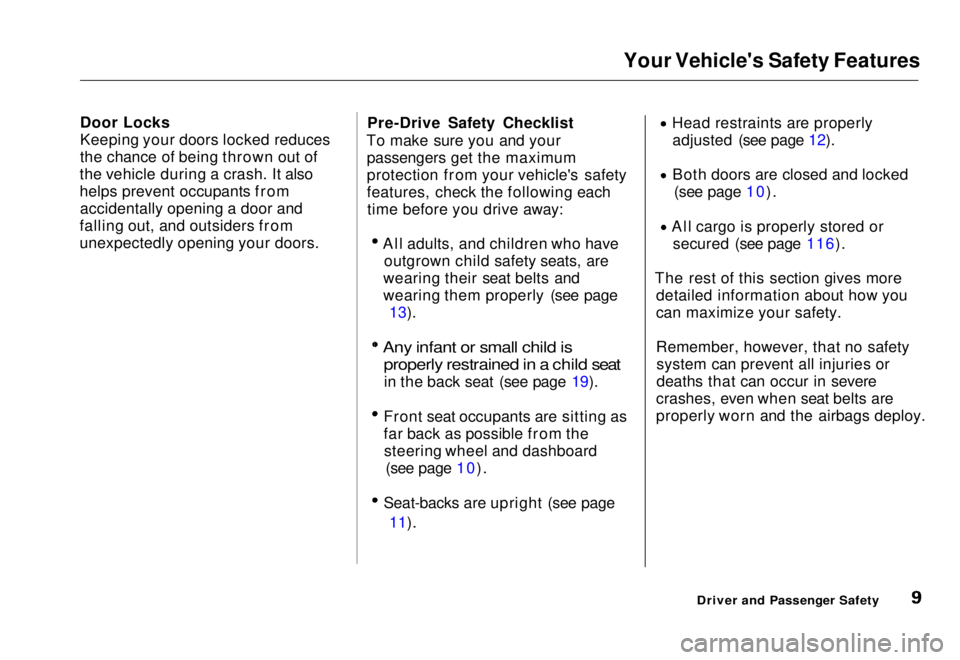
Your Vehicle's Safety Features
Door Locks
Keeping your doors locked reduces
the chance of being thrown out of
the vehicle during a crash. It also
helps prevent occupants from accidentally opening a door and
falling out, and outsiders from
unexpectedly opening your doors. Pre-Drive Safety Checklist
To make sure you and your passengers get the maximum
protection from your vehicle's safety
features, check the following eachtime before you drive away:
All adults, and children who haveoutgrown child safety seats, are
wearing their seat belts and
wearing them properly (see page 13).
Any infant or small child is properly restrained in a child seat
in the back seat (see page 19).
Front seat occupants are sitting as
far back as possible from the steering wheel and dashboard (see page 10). Seat-backs are upright (see page
11). Head restraints are properly
adjusted (see page 12).
Both doors are closed and locked (see page 10). All cargo is properly stored or
secured (see page 116).
The rest of this section gives more detailed information about how you
can maximize your safety.
Remember, however, that no safetysystem can prevent all injuries or
deaths that can occur in severe
crashes, even when seat belts are
properly worn and the airbags deploy.
Driver and Passenger SafetyMain Menu Table of Contents s t
Page 12 of 251
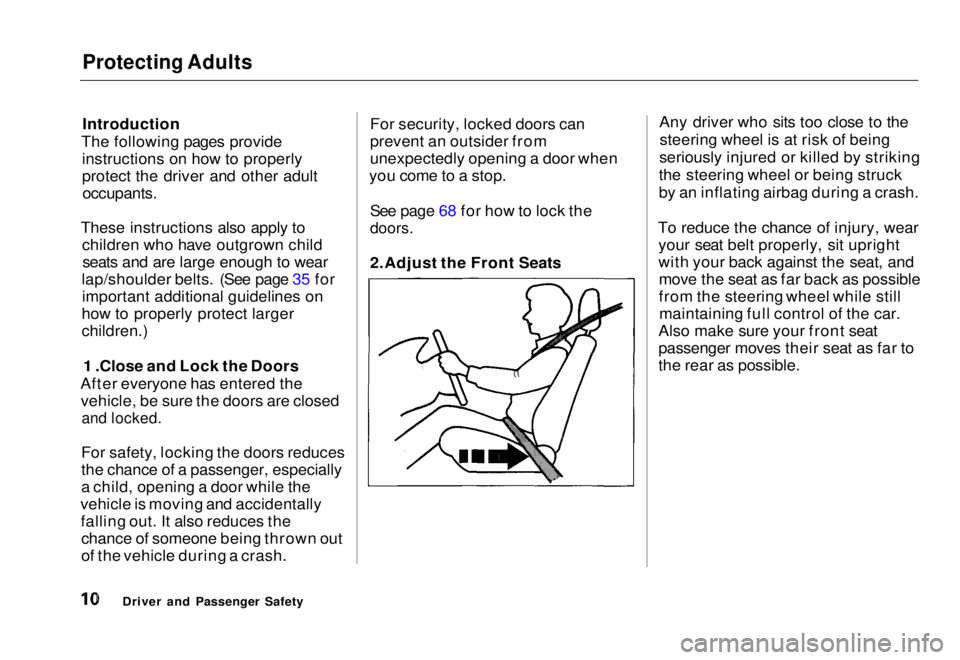
Protecting Adults
Introduction
The following pages provide instructions on how to properly
protect the driver and other adult
occupants.
These instructions also apply to children who have outgrown childseats and are large enough to wear
lap/shoulder belts. (See page 35 for important additional guidelines on
how to properly protect larger
children.)
1 .Close and Lock the Doors
After everyone has entered the vehicle, be sure the doors are closed
and locked.
For safety, locking the doors reduces
the chance of a passenger, especially
a child, opening a door while the
vehicle is moving and accidentally falling out. It also reduces thechance of someone being thrown out
of the vehicle during a crash. For security, locked doors can
prevent an outsider from
unexpectedly opening a door when
you come to a stop.
See page 68 for how to lock the
doors.
2.Adjust the Front Seats Any driver who sits too close to the
steering wheel is at risk of being
seriously injured or killed by striking
the steering wheel or being struck
by an inflating airbag during a crash.
To reduce the chance of injury, wear your seat belt properly, sit upright
with your back against the seat, andmove the seat as far back as possible
from the steering wheel while stillmaintaining full control of the car.
Also make sure your front seat
passenger moves their seat as far to
the rear as possible.
Driver and Passenger SafetyMain Menu Table of Contents s t
Page 13 of 251
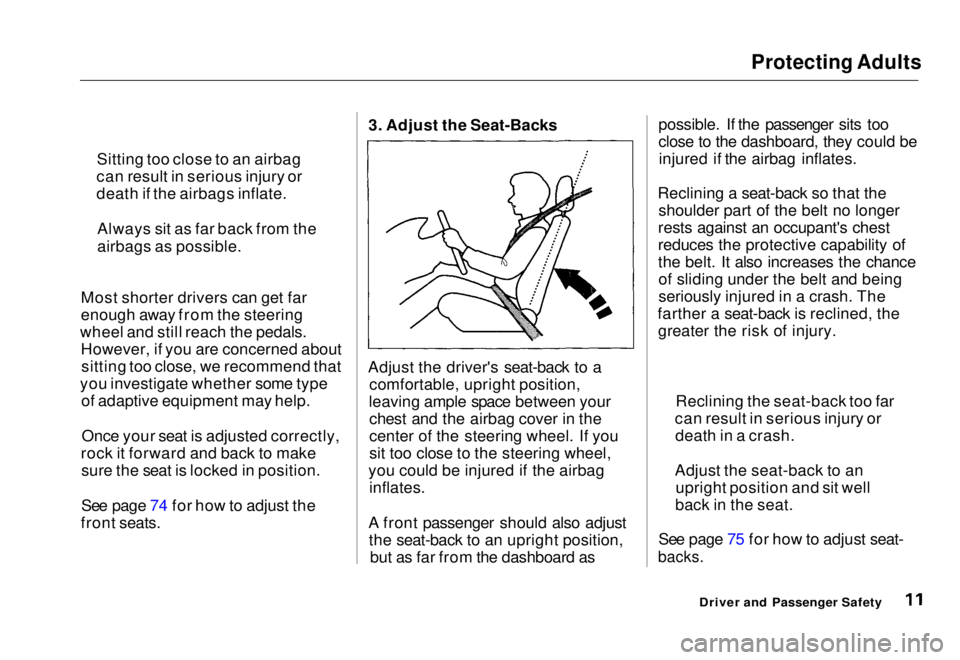
Protecting Adults
Most shorter drivers can get far
enough away from the steering
wheel and still reach the pedals. However, if you are concerned aboutsitting too close, we recommend that
you investigate whether some type of adaptive equipment may help.
Once your seat is adjusted correctly,
rock it forward and back to make sure the seat is locked in position.
See page 74 for how to adjust the
front seats. 3. Adjust the Seat-Backs
Adjust the driver's seat-back to a comfortable, upright position,
leaving ample space between your chest and the airbag cover in the
center of the steering wheel. If you
sit too close to the steering wheel,
you could be injured if the airbag inflates.
A front passenger should also adjust the seat-back to an upright position, but as far from the dashboard as possible. If the passenger sits too
close to the dashboard, they could be
injured if the airbag inflates.
Reclining a seat-back so that the shoulder part of the belt no longer
rests against an occupant's chest
reduces the protective capability of
the belt. It also increases the chance of sliding under the belt and being
seriously injured in a crash. The
farther a seat-back is reclined, the greater the risk of injury.
See page 75 for how to adjust seat-
backs.
Driver and Passenger Safety
Sitting too close to an airbag
can result in serious injury or
death if the airbags inflate.
Always sit as far back from the
airbags as possible.
Reclining the seat-back too far
can result in serious injury or death in a crash.
Adjust the seat-back to an upright position and sit well
back in the seat.Main Menu Table of Contents s t
Page 14 of 251
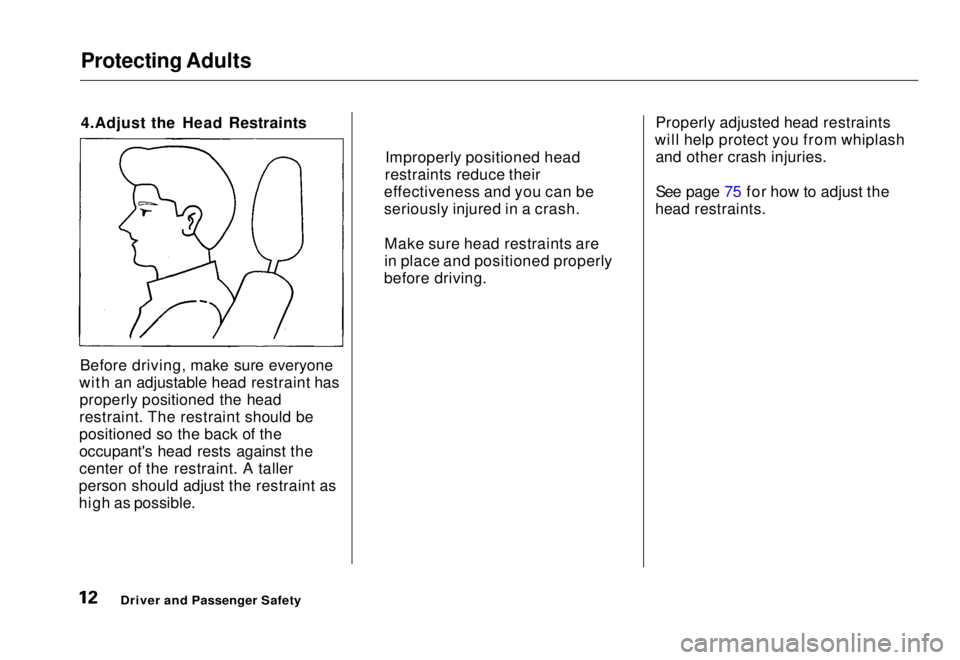
Protecting Adults
4.Adjust the Head Restraints
Before driving, make sure everyone
with an adjustable head restraint has properly positioned the head
restraint. The restraint should be
positioned so the back of the
occupant's head rests against the
center of the restraint. A taller
person should adjust the restraint as
high as possible. Properly adjusted head restraints
will help protect you from whiplash and other crash injuries.
See page 75 for how to adjust the
head restraints.
Driver and Passenger Safety
Improperly positioned head
restraints reduce their
effectiveness and you can be
seriously injured in a crash.
Make sure head restraints are
in place and positioned properly
before driving.Main Menu Table of Contents s t
Page 15 of 251
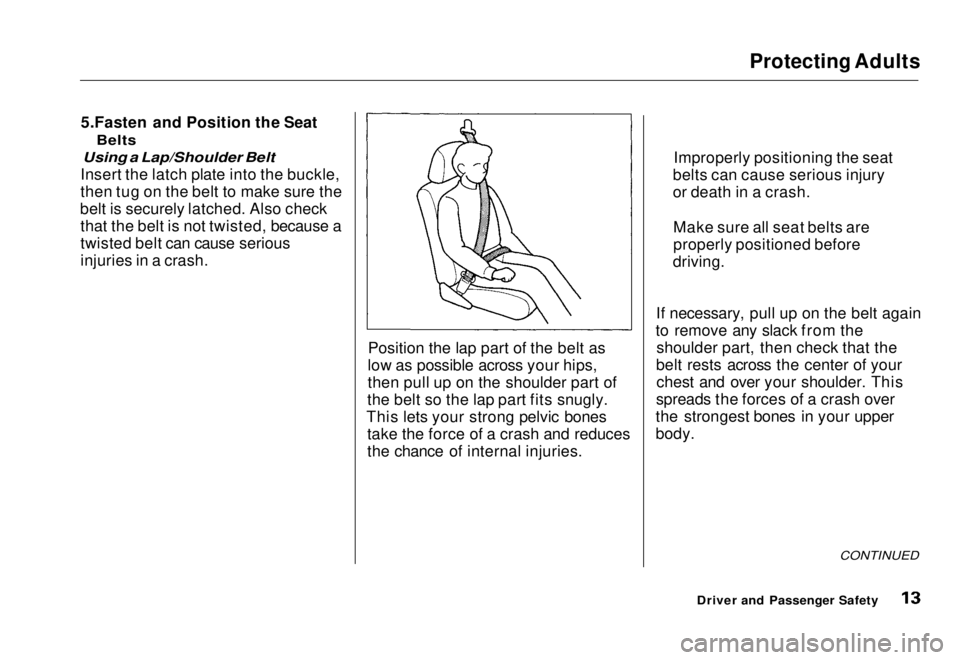
Protecting Adults
5.Fasten and Position the Seat
Belts
Using a Lap/Shoulder Belt
Insert the latch plate into the buckle,
then tug on the belt to make sure the
belt is securely latched. Also check that the belt is not twisted, because a
twisted belt can cause serious
injuries in a crash.
Position the lap part of the belt as
low as possible across your hips,
then pull up on the shoulder part of
the belt so the lap part fits snugly.
This lets your strong pelvic bones take the force of a crash and reduces
the chance of internal injuries. If necessary, pull up on the belt again
to remove any slack from the shoulder part, then check that the
belt rests across the center of your chest and over your shoulder. This
spreads the forces of a crash over
the strongest bones in your upper
body.
CONTINUED
Driver and Passenger Safety
Improperly positioning the seat
belts can cause serious injury
or death in a crash.
Make sure all seat belts are
properly positioned before
driving.Main Menu Table of Contents s t
Page 16 of 251
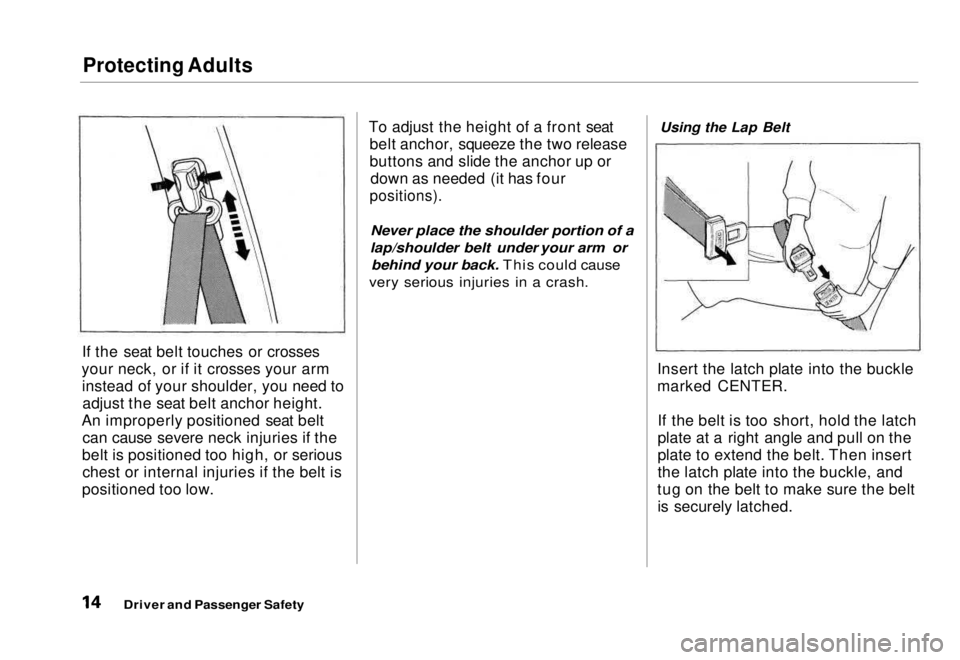
Protecting Adults
If the seat belt touches or crosses
your neck, or if it crosses your arm instead of your shoulder, you need toadjust the seat belt anchor height.
An improperly positioned seat belt can cause severe neck injuries if the
belt is positioned too high, or serious chest or internal injuries if the belt is
positioned too low. To adjust the height of a front seat
belt anchor, squeeze the two release
buttons and slide the anchor up ordown as needed (it has four
positions).
Never place the shoulder portion of a
lap/shoulder belt under your arm or behind your back. This could cause
very serious injuries in a crash.
Using the Lap Belt
Insert the latch plate into the buckle
marked CENTER. If the belt is too short, hold the latch
plate at a right angle and pull on the
plate to extend the belt. Then insert
the latch plate into the buckle, and
tug on the belt to make sure the belt is securely latched.
Driver and Passenger SafetyMain Menu Table of Contents s t
Page 17 of 251
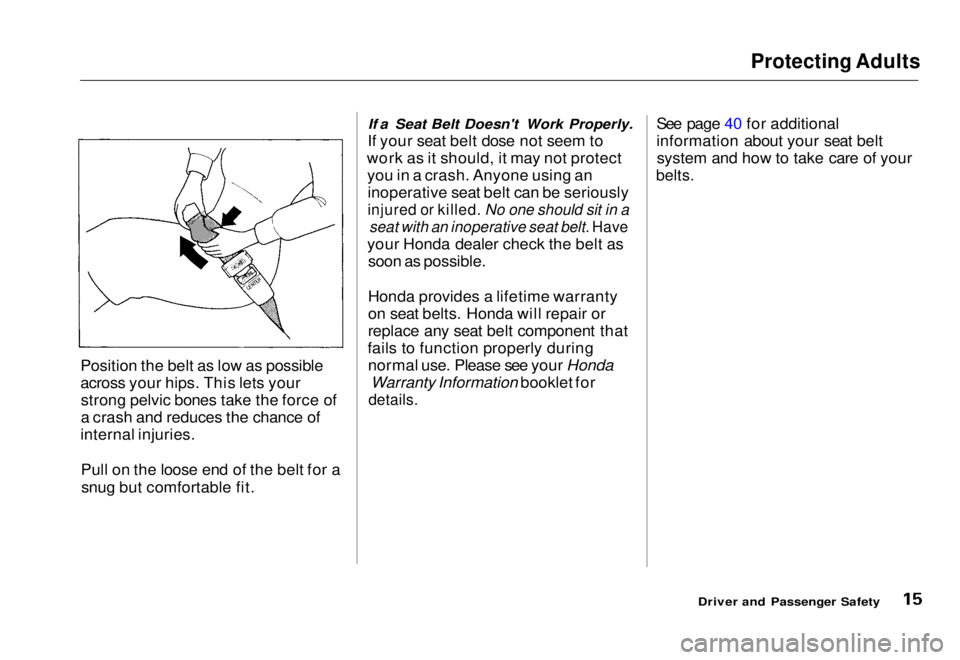
Protecting Adults
Position the belt as low as possible
across your hips. This lets your strong pelvic bones take the force of
a crash and reduces the chance of
internal injuries.
Pull on the loose end of the belt for asnug but comfortable fit.
If a Seat Belt Doesn't Work Properly.
If your seat belt dose not seem to
work as it should, it may not protect you in a crash. Anyone using aninoperative seat belt can be seriously
injured or killed. No one should sit in a
seat with an inoperative seat belt. Have
your Honda dealer check the belt as soon as possible.
Honda provides a lifetime warranty
on seat belts. Honda will repair or
replace any seat belt component that
fails to function properly during normal use. Please see your Honda Warranty Information booklet for
details.
See page 40 for additional
information about your seat belt
system and how to take care of your
belts.
Driver and Passenger SafetyMain Menu Table of Contents s t
Page 18 of 251
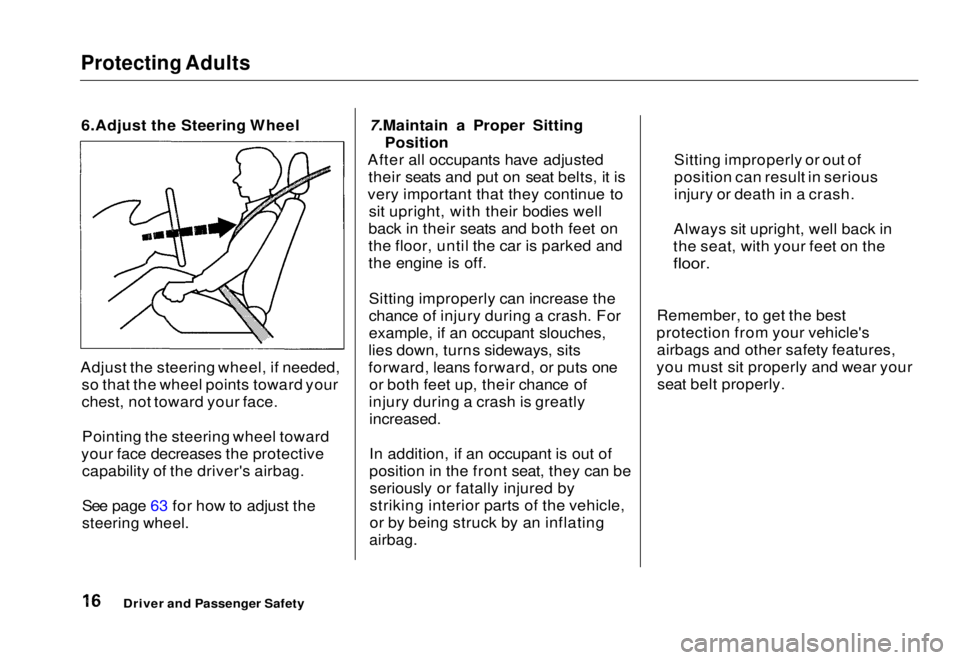
Protecting Adults
6.Adjust the Steering Wheel
Adjust the steering wheel, if needed, so that the wheel points toward your
chest, not toward your face.
Pointing the steering wheel toward
your face decreases the protective capability of the driver's airbag.
See page 63 for how to adjust the
steering wheel.
7.Maintain a Proper Sitting
Position
After all occupants have adjusted their seats and put on seat belts, it is
very important that they continue to sit upright, with their bodies well
back in their seats and both feet on
the floor, until the car is parked and
the engine is off.
Sitting improperly can increase the
chance of injury during a crash. For
example, if an occupant slouches,
lies down, turns sideways, sits
forward, leans forward, or puts one or both feet up, their chance of
injury during a crash is greatly
increased.
In addition, if an occupant is out of
position in the front seat, they can beseriously or fatally injured by
striking interior parts of the vehicle,
or by being struck by an inflating
airbag.
Remember, to get the best
protection from your vehicle's airbags and other safety features,
you must sit properly and wear your seat belt properly.
Driver and Passenger Safety Sitting improperly or out of
position can result in serious
injury or death in a crash.
Always sit upright, well back in
the seat, with your feet on the
floor.Main Menu Table of Contents s t
Page 19 of 251
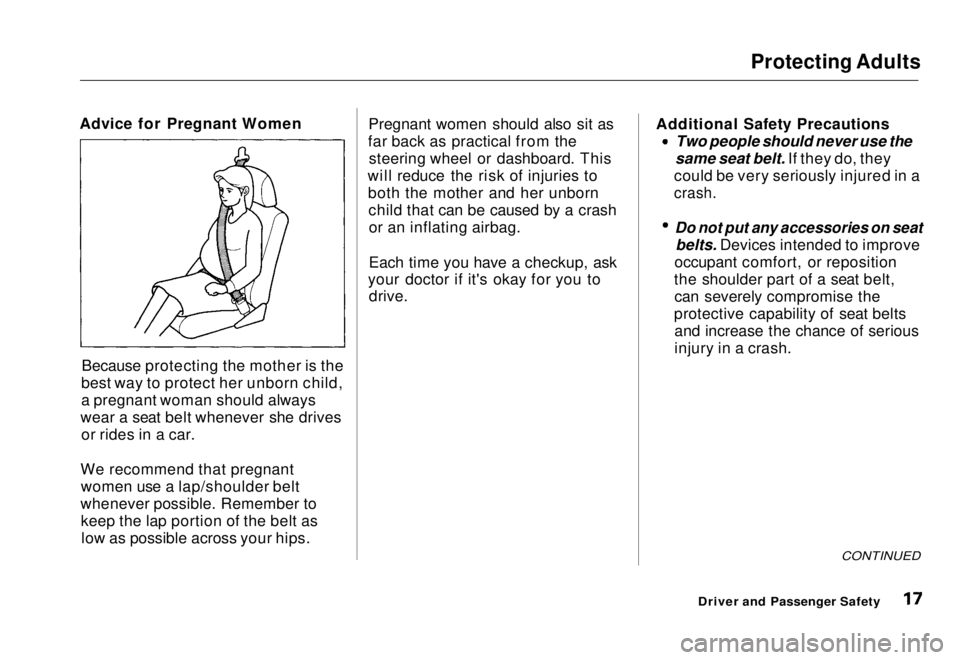
Protecting Adults
Advice for Pregnant Women
Because protecting the mother is the
best way to protect her unborn child,
a pregnant woman should always
wear a seat belt whenever she drives or rides in a car.
We recommend that pregnant women use a lap/shoulder belt
whenever possible. Remember to keep the lap portion of the belt aslow as possible across your hips. Pregnant women should also sit as
far back as practical from the steering wheel or dashboard. This
will reduce the risk of injuries to both the mother and her unbornchild that can be caused by a crashor an inflating airbag.
Each time you have a checkup, ask
your doctor if it's okay for you to drive. Additional Safety Precautions
Two people should never use the
same seat belt. If they do, they
could be very seriously injured in a
crash.
Do not put any accessories on seat
belts. Devices intended to improve
occupant comfort, or reposition
the shoulder part of a seat belt, can severely compromise the
protective capability of seat belts and increase the chance of serious
injury in a crash.
CONTINUED
Driver and Passenger SafetyMain Menu Table of Contents s t
Page 20 of 251

Protecting Adults
Do not place hard or sharp objects
between yourself and an airbag.
Carrying hard or sharp objects on
your lap, or driving with a pipe or other sharp object in your mouth,
can result in injuries if your
airbags inflate.
Keep your hands and arms away
from the airbag covers.
If your hands or arms are close to
the SRS covers in the center of the steering wheel and on top of the
dashboard, they could be injured if
the airbags inflate.
Driver and Passenger SafetyMain Menu Table of Contents s t